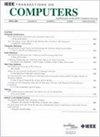HiCoCS: High Concurrency Cross-Sharding on Permissioned Blockchains
IF 3.8
2区 计算机科学
Q2 COMPUTER SCIENCE, HARDWARE & ARCHITECTURE
引用次数: 0
Abstract
As the foundation of the Web3 trust system, blockchain technology faces increasing demands for scalability. Sharding emerges as a promising solution, but it struggles to handle highly concurrent cross-shard transactions (HiCoCS:许可区块链上的高并发交叉分片
区块链技术作为Web3信任体系的基础,面临着日益增长的可扩展性需求。分片作为一种很有前途的解决方案出现,但它很难处理高度并发的跨分片事务(CSTxs),这主要是由于在同一帐户上同时进行分类账操作。Hyperledger Fabric是一种被许可的bb0,它采用多版本并发控制进行并行处理。现有的解决方案使用通道和中介来实现Hyperledger Fabric中的交叉分片。然而,高并发cstx导致的冲突问题并没有得到充分解决。为了填补这一空白,我们提出了HiCoCS,这是一种用于许可区块链的高并发跨分片方案。HiCoCS通过引入复合键结构为每个CSTx创建一个唯一的虚拟子代理,从而在减少资源开销的同时实现无冲突的并发事务处理。挑战在于管理大量的组合密钥和降低中间隐私风险。HiCoCS利用虚拟子代理在维护事务池的同时并发地接收和处理cstx。通过批处理将池中的多个cstx合并,提高了效率。我们探索组合键重用,以减少虚拟子代理的数量并降低系统开销。使用同态加密增强了隐私保护。评估表明,与基线相比,HiCoCS将跨分片事务吞吐量提高了3.5-20.2倍。
本文章由计算机程序翻译,如有差异,请以英文原文为准。
求助全文
约1分钟内获得全文
求助全文
来源期刊

IEEE Transactions on Computers
工程技术-工程:电子与电气
CiteScore
6.60
自引率
5.40%
发文量
199
审稿时长
6.0 months
期刊介绍:
The IEEE Transactions on Computers is a monthly publication with a wide distribution to researchers, developers, technical managers, and educators in the computer field. It publishes papers on research in areas of current interest to the readers. These areas include, but are not limited to, the following: a) computer organizations and architectures; b) operating systems, software systems, and communication protocols; c) real-time systems and embedded systems; d) digital devices, computer components, and interconnection networks; e) specification, design, prototyping, and testing methods and tools; f) performance, fault tolerance, reliability, security, and testability; g) case studies and experimental and theoretical evaluations; and h) new and important applications and trends.
 求助内容:
求助内容: 应助结果提醒方式:
应助结果提醒方式:


